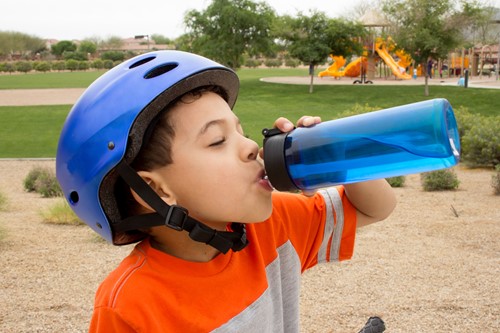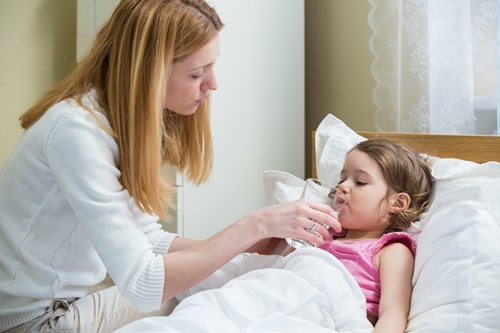
Fluids and Hydration
7/11/2022
We all need water to survive. Water is essential to our body’s functioning. It helps our blood circulate, helps us digest food and eliminate waste from our body. It keeps our bones and joints healthy and also improves attention, memory, and mood.
FLUID INTAKE
Fluid intake increases as we grow bigger and older. We also need more fluids when we are active, have a fever, or are in warmer climates. How much fluid do children need?
Babies under 6 months of age will get all the fluids they need via breastmilk or formula. Most babies drink between 28-36 ounces of breastmilk or formula daily.
Between 6-9 months of age, a baby can have up to 4 ounces of water a day in addition to formula or breastmilk. This increases to 8 ounces between 9-12 months. Toddlers need 4 cups of fluids every day, school age children need 5 cups, and older children need 7-8 cups of fluids per day.
If a child is exercising or participating in a sport, they may need 3-8 ounces additional fluid for every 20 minutes of vigorous exercise. If they are exercising vigorously for over an hour, an electrolyte drink or supplement may be necessary to ensure proper hydration.

TYPE OF FLUID
Water is a healthy and easy way to stay hydrated but we also get water from fruits, milk, juices, and other beverages. Water or milk should be the primary fluids that children consume. We do not recommend juice for children under the age of 1. After age one, we recommend limiting juice to less than 4 ounces per day and if possible, we recommend avoiding daily juice intake if possible. Often juices have excessive sugar and very few nutrients. Fresh fruits, which provide fluid, vitamin and minerals, and fiber, are preferable to fruit juices. Soda and other sugary beverages should be served on rare occasions.
Twenty percent of hydration needs are actually met with food! Fruits and veggies contain lots of water. Some are made up of over 90% water! Watermelon, cantaloupe, strawberries, blueberries, grapefruit, cucumber, zucchini, iceberg lettuce, tomatoes, and celery are high in water. Other foods contain high water content including yogurt (85% water) and ice cream (64% water)!
What if your child doesn’t like water? Make their water fun! You can add fun shaped ice cubes or cut up fruit. If necessary, add a tiny splash of juice for flavoring. Fun straws and cups can help children become more interested in water. Also remember, alternative ways to get fluid in but may be more interesting and fun for kids such as popsicles made from water and fruit. Smoothies can count as fluid source and are a great way to sneak in fruits and veggies!

DEHYDRATION
Young children are more at risk for becoming dehydrated. They have smaller bodies that are less efficient at conserving water. This is particularly true if your child has a fever, is vomiting, or has diarrhea. And when they have all 3 symptoms at the same time, they are at significant risk of dehydration and water loss.
When a child loses water and doesn’t maintain hydration, they also lose electrolytes including sodium, potassium, and chloride. These are essential for the body to conduct nerve impulses, contract muscles including the heart, and regulate the body’s fluid balance.
Signs of Dehydration
A child with mild dehydration may have the following symptoms:
- Urinating less frequently
- Darker colored urine
- Headache
- Playing less
- Thirst
- Parched or dry mouth
- Fewer tears
- Sunken soft spot
A child with moderate or severe dehydration may have the above symptoms as well as:
- Severe fussiness or irritability
- Sleepy or listless
- Sunken eyes
- Flushed skin
- Cool/discolored hands and feet
- Wrinkly skin
- Decreased or no urination
- Lightheadedness
- Cramping
- Rapid pulse
- Feels very hot or very cold
- No tears when crying

Minimum Intake
When a child is sick, they need lots of fluids. But how much fluid do they need in 24 hours to maintain hydration and minimize the risk of dehydration?
|
Weight |
Minimum |
With diarrhea |
|
Under 10lbs |
10 ounces or 1.25 cups (300 ml) |
16 ounces or 2 cups (480 ml) |
|
Under 20 lbs |
15 ounces or about 2 cups (450 ml) |
23 ounces or about 3 cups (690 ml) |
|
Under 25 lbs |
25 ounces or about 3 cups (750 ml) |
40 ounces or 5 cups (1.2 L) |
|
Under 30 lbs |
28 ounces or 3.5 cups (840 ml) |
44 ounces or 5.5 cups (1.32 L) |
|
Under 35 lbs |
32 ounces or 4 cups (960 ml) |
51 ounces or about 6 cups (1.53 L) |
|
40lbs and over |
38 ounces or 4.5 cups (1.14L) |
61 ounces or about 7 cups (1.83 L) |
When your child is sick, has a fever, or has diarrhea, encourage them to take small, frequent amounts of fluid or food. Small frequent fluid intake helps to ensure hydration and encouraging smaller amounts can be more successful and less overwhelming for children.
You can provide a variety of types of fluids, fruits, yogurt, smoothies, applesauces, juices, ice chips, popsicles, and soups to older children. A baby should be offered formula or breast milk if under 6 months of age, over 6 months of age, hydrating fruits and veggies can also be offered.
If your child is unwilling or unable to eat during illness, water cannot be the only fluid offered. You also need to provide fluids with electrolyte and some calories/nutrition. Some suggestions of things to offer include:
- Popsicles
- Commercial rehydration solutions (these help with sodium and potassium)
- Sports Drinks
- Diluted fruit juice (straight juice can increase diarrhea)
- Soup broth, bone broth, or stock
If your toddler or older child is vomiting, they may be thirsty but their stomach will be very sensitive to large sips or gulps of fluid. Slow rehydration works best. Start with 1 teaspoon (1 teaspoon is 5 ml of fluid) of water or rehydration solution every 5 minutes and increase the amount every 20-30 minutes as follows:
0 to 20 or 30 minutes: 1 tsp or 5 ml every 5 minutes
20-30 minutes to 40-60 minutes: 2 tsp or 10 ml every 5 minutes
40-60 minutes to 80-90 minutes: 3 tsp or 15 ml every 5 minutes
Over 80-90 minutes: 4 tsp or 20 ml every 5 minutes
If your child starts vomiting at larger amounts, return to the largest amount tolerated or begin back at 5 ml. Once they can hold down 20 ml every 5 minutes, encourage sipping fluid frequently. While working on slow hydration, they can also be taking small licks of a popsicle, sucking on ice chips, or even on a wash cloth dipped in water, juice, or a rehydration solution.
If a baby is vomiting, they should be offered a rehydration solution in small amounts like above. This can be offered via a bottle or even a syringe. You can also make popsicles or ice cubes from frozen milk or formula that can be served in silicone or mesh feeders.
Once babies and infants are tolerating a few ounces of rehydration solution, they can be offered breast milk or half-strength formula. Half-strength formula is made by making a bottle that is equal parts normally made formula with rehydration solution. So if you are making a 4 ounce bottle, it would be 2 ounces of normally made formula with 2 ounces of rehydration solution. Once they are tolerating half-strength formula, then they can return to full strength formula and normal sized bottles.
If your child has tolerated a few hours of fluids without vomiting, then you can start introducing food back into their diet.
Please call your provider or seek care urgently If your child is unable to stop vomiting, can’t hold down even small amounts of fluid after a few hours or has any of the following symptoms
- Prolonged fever
- Severe abdominal pain
- Bloody stools
- Vomiting longer than 24 hours
- Vomiting coffee grounds or green material (not yellow material)
- Distended abdomen
- Refusing to eat or drink
- Yellow appearing skin
- New appearing rashes
- Signs of moderate or severe dehydration
- Signs of mild dehydration that do not improve with increased hydration
You should also call the office if your child has a SUDDEN increase in fluid intake and is urinating more frequently than usual.
Adequate fluid intake is essential to a healthy, properly functioning body. Children are at higher risk for dehydration due to smaller bodies, greater fluid losses, and inefficient water conservation. When they are ill, it is important to provide and encourage fluid intake. If your child is showing any signs of dehydration, please do not hesitate to call for an evaluation.
Children’s Health Care of Newburyport, Massachusetts and Haverhill, Massachusetts is a pediatric healthcare practice providing care for families across the North Shore, Merrimack Valley, southern New Hampshire, and the Seacoast regions. The Children’s Health Care team includes pediatricians and pediatric nurse practitioners who provide comprehensive pediatric health care for children, including newborns, toddlers, school aged children, adolescents, and young adults. Our child-centered and family-focused approach covers preventative and urgent care, immunizations, and specialist referrals. Our services include an on-site pediatric nutritionist, special needs care coordinator, and social workers. We also have walk-in appointments available at all of our locations for acute sick visits. Please visit chcmass.com where you will find information about our pediatric doctors, nurse practitioners, as well as our hours and services.
Disclaimer: this health information is for educational purposes only. You, the reader, assume full responsibility for how you choose to use it.








